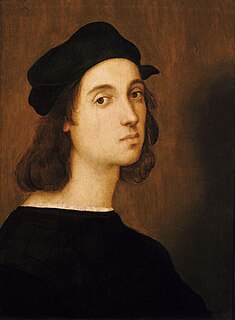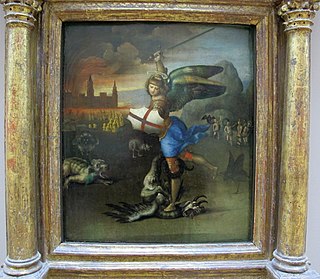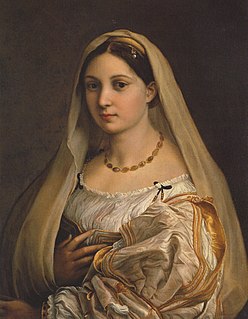
Raffaello Sanzio da Urbino, better known as Raphael, was an Italian painter and architect of the High Renaissance. His work is admired for its clarity of form, ease of composition, and visual achievement of the Neoplatonic ideal of human grandeur. Together with Leonardo da Vinci and Michelangelo, he forms the traditional trinity of great masters of that period.

Pietro Bembo, O.S.I.H. was an Italian scholar, poet, and literary theorist who also was a member of the Knights Hospitaller, and a cardinal of the Roman Catholic Church. As an intellectual of the Italian Renaissance, Pietro Bembo greatly influenced the development of the Tuscan dialect as a literary language for poetry and prose, which, by later codification into a standard language, became the modern Italian language. In the 16th century, Bembo's poetry, essays and books proved basic to reviving interest in the literary works of Petrarch. In the field of music, Bembo's literary writing techniques helped composers develop the techniques of musical composition that made the madrigal the most important secular music of 16th-century Italy.

Ginevra de' Benci is a portrait painting by Leonardo da Vinci of the 15th-century Florentine aristocrat Ginevra de' Benci. Exhibited at the National Gallery of Art in Washington, D.C., it is the only painting by Leonardo on public view in the Americas.

Sebastiano del Piombo was an Italian painter of the High Renaissance and early Mannerist periods famous as the only major artist of the period to combine the colouring of the Venetian school in which he was trained with the monumental forms of the Roman school. He belongs both to the painting school of his native city, Venice, where he made significant contributions before he left for Rome in 1511, and that of Rome, where he stayed for the rest of his life, and whose style he thoroughly adopted.

The Venus of Urbino is an oil painting by the Italian painter Titian, which seems to have been begun in 1532 or 1534, and was perhaps completed in 1534, but not sold until 1538. It depicts a nude young woman, traditionally identified with the goddess Venus, reclining on a couch or bed in the sumptuous surroundings of a Renaissance palace. It is now in the Galleria degli Uffizi in Florence.

St. Michael Vanquishing Satan is a painting by the Italian High Renaissance artist Raphael. The image consists of the archangel Raphael standing on top of Satan's back with his right foot. Both works have been located in the Louvre in Paris since 1667. The painting was commissioned by Pope Leo X.

The Garvagh Madonna is an oil painting by the Italian Renaissance artist Raphael, dating to c. 1509–1510. It depicts the Virgin, the Christ Child and the infant John the Baptist, and is one of many paintings by Raphael with this trio. It is from early in the artist's third, or Roman period, in which distinctive changes are seen from his Umbrian or Florentine period in style and use of colour, with the introduction of more natural subjects and settings.

The Madonna della Seggiola or The Madonna della Sedia is an oil on panel Madonna painting by the High Italian Renaissance artist Raphael, executed c. 1513–1514, and housed at the Palazzo Pitti Collection in Florence, Italy. Although there is documentation on its arrival to its current location, Palazzo Pitti, it is still unknown who commissioned the painting; however, it has been in the Medici family since the 16th century.
Gli Asolani are dialogues in three books written between 1497 and 1504 by Pietro Bembo in the language of Petrarch and comprise his first important work. Although he had shown a copy to Lucrezia Borgia in 1503, the first edition from 1505 was published by Aldo Manuzio, and the second edition was published, after various revisions, in 1530. They concern a dialogue on love that is supposed to have happened at Asolo near the court of Caterina Cornaro.

The Portrait of Andrea Navagero e Agostino Beazzano is a painting by the Italian High Renaissance painter Raphael, created in 1516. It is housed in the Galleria Doria Pamphilj, Rome.

Portrait of a Cardinal, or simply The Cardinal, is an oil on panel painting by the Italian Renaissance artist Raphael, dated to c. 1510–1511. It is held by the Prado Museum in Madrid.

Baldassare Castiglione, count of Casatico, was an Italian courtier, diplomat, soldier and a prominent Renaissance author.

Portrait of Tommaso Inghirami is an oil painting by Italian artist Raphael. Painted ca. 1509, it exists in two copies, one of which is in display in the Palatina Gallery of Palazzo Pitti in Florence and the other in the Isabella Stewart Gardner Museum in Boston. Known for its realism and attention to detail, the image is reminiscent of works by Hans Holbein the Elder, by whom Raphael may have been influenced in its execution. Stylistically, it relates to Raphael's Portrait of Agnolo Doni, ca.1506, in what Claudio Strinati described in 1998 as its "merciless clarity."

St. Michael is an oil painting by Italian artist Raphael. Also called the Little St. Michael to distinguish it from a larger, later treatment of the same theme, St. Michael Vanquishing Satan, it is housed in the Louvre in Paris. The work depicts the Archangel Michael in combat with the demons of Hell, while the damned suffer behind him. Along with St. George, it represents the first of Raphael's works on martial subjects.

Portrait of Pope Julius II is an oil painting of 1511–12 by the Italian High Renaissance painter Raphael. The portrait of Pope Julius II was unusual for its time and would carry a long influence on papal portraiture. From early in its life, it was specially hung at the pillars of the church of Santa Maria del Popolo, on the main route from the north into Rome, on feast and high holy days. Giorgio Vasari, writing long after Julius' death, said that "it was so lifelike and true it frightened everyone who saw it, as if it were the living man himself".

The St. Cecilia Altarpiece is an oil painting by the Italian High Renaissance master Raphael. Completed in his later years, in around 1516–17, the painting depicts Saint Cecilia, the patron saint of musicians and Church music, listening to a choir of angels in the company of St. Paul, St. John the Evangelist, St. Augustine and Mary Magdalene. Commissioned for a church in Bologna, the painting now hangs in that city's Pinacoteca Nazionale. According to Giorgio Vasari the musical instruments strewn about Cecilia's feet were not painted by Raphael but by his student, Giovanni da Udine.

Margarita Luti was the mistress and model of Raphael. The story of their love has become "the archetypal artist–model relationship of Western tradition", yet little is known of her life. Of her, Flaubert wrote, in his Dictionary of Received Ideas, "Fornarina. She was a beautiful woman. That is all you need to know."

Portrait of Doña Isabel de Requesens y Enríquez de Cardona-Anglesola is an oil painting dated circa 1518 that was formerly believed to depict Giovanna d'Aragona. It has been variously ascribed to Raphael, Giulio Romano, or the school of Raphael; it is now usually taken to have been executed by Giulio Romano based on a sketch by Raphael and then altered by Raphael. The painting is now in the Louvre Museum in Lens.

Adoration of the Shepherds is the title of a lost drawing by Raphael, described in a letter of 8 September 1508, from Raphael to his friend Francesco Raibolini alias Francesco Francia. This letter's contents were first published in 1678, in Carlo Cesare Malvasia's book Felsina Pittrice. Malvasia gave a full account of the letter, which he claimed to have found among the papers of Count Antonio Lambertini in Bologna. While the existence and contents of the letter are disputed, according to Malvasia it described the delivery of a drawing of the Adoration of the Shepherds to Francesco Francia. This drawing has been considered lost or never to have existed.

The Bembo were a noble Venetian family, part of the Venetian families of most ancient origins.



















